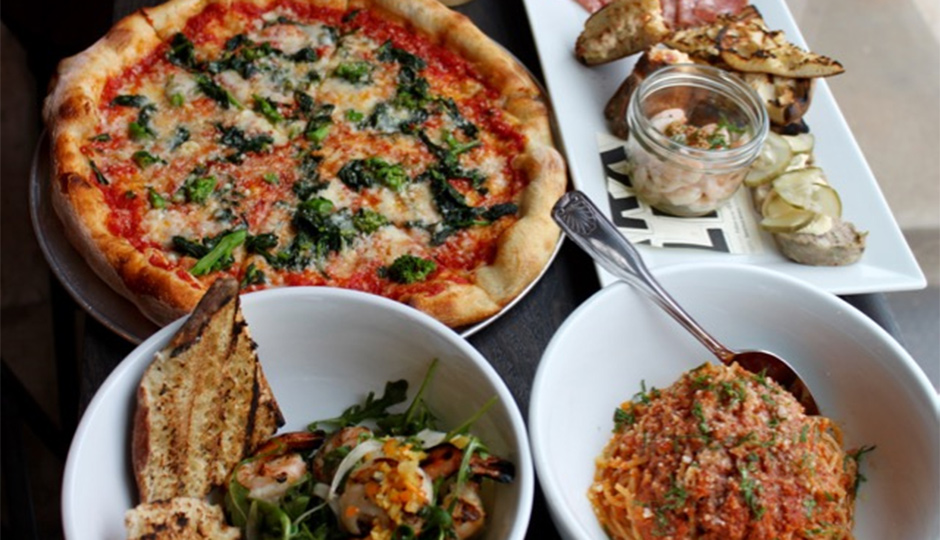Looking Back: The Best (And Worst) Restaurants Of 2016, Part 2
With 2016 coming to a close, we’re taking this week to look back at the year in restaurants. And while things didn’t start off great (for starters, two of the first six restaurants I reviewed were closed before the year was done), with the spring came a turning point and the opening of some of the best restaurants of the year.
So let’s keep going, shall we? We pick things back up in March with the review of the new steakhouse that came in to take the place of Fountain at the Four Seasons…
Blood And Gingham: Urban Farmer Reviewed
Urban Farmer was expensive. There were service issues and design issues and, at its core, it is still a steakhouse with all of a steakhouse’s problems in this modern restaurant landscape. But the crew from Sage Restaurant Group who came into town somehow managed to win my respect anyway. How?
[Because] Urban Farmer isn’t a common steakhouse. It somehow manages to tap-dance through a minefield of potentially murderous conceptual failures and pull off a very complicated trick by going modern and old-fashioned at the same time. It’s bright and airy (as opposed to dim and cloistered); it eschews paintings of horses in favor of black-and-white abstracts and things made out of barrel staves. It doesn’t have a shrimp cocktail on the menu or piping bags full of mashed potatoes waiting in the back, but it has enough jars of pickled vegetables racked up to be featured in a Portlandia sketch. The farmer’s-daughter costumes on the female servers are bullshit (I’m surprised some manager doesn’t paint freckles on their noses every night before service), and the whole rusticated country-mouse shtick is a blatant bit of anti-class positioning. But the kitchen? Dammit, I love those guys. And for precisely two reasons.
1.They know how to cook the hell out of a steak.
2. Someone in the organization found a way to make those steaks interesting again—by treating them like charcuterie.
And that was no small thing. It made a huge difference in my ultimate opinion of the place–the talent in the kitchen and their ability to make a steakhouse menu interesting again. I still have fond memories of my meals at Urban Farmer. The accounting department who handles my expense reports? Maybe not so much.
But hey, for all of its faults, Urban Farmer was certainly better than what came next–a complicated, confused and ultimately disappointing review of Mike Stollenwerk’s 26 North. If the crew at Urban thought they’d gotten it rough, they were probably grateful when they read my critique of the dining room at 26 North.
It was a terrible lunch. I hated it. Every single minute. The service was vacant and weirdly dismissive. The menu was like a powerful sedative. It could be used to put bears to sleep at the Zoo. Whatever they had on the radio sounded like it’d been composed by John Tesh’s less talented cousin—the kind of Muzak they play in the waiting room of Hell’s third-worst dentist’s office—and the space, in the fullness of daylight, looked like it’d been designed by someone who had never been inside an actual restaurant before and had been given only dog-eared 20-year-old issues of Gourmet as reference material.
And even though I would go back and ultimately like the place during dinner, there was just no getting past the damage that’d been done. 26 North didn’t survive 2016 either. It closed a few months later.

Photo by Emily Teel
The Stupid Joy Of Simple Things: Clarkville Reviewed
After a rough few months in restaurant world, maybe I just needed a break. A sunny weekend, a perfect day, a few beers and some fried chicken. And that’s just what Clarkville offered.
What I remember is sitting there in a corner booth, leaning back into a sunbeam with chicken grease on my fingers and an Allagash White close at hand. I remember smiling because it was just a good moment. What I liked most about Clarkville was the stupid joy of simple things. Eating fried chicken on a spring afternoon. Running the crust of a slice through the thick ragu in the bottom of the bowl and licking a smear of it off my knuckles while Lou Reed sang and the servers moved through a crowd of just-arrived families from the park. I liked the boy at the table next to mine trying to share his Cheerios and raisins with me while his mom breathed out a happy sigh and decided that yeah, she would have a beer with her lunch after all. The hand-pulled mozzarella was squeaky-stiff, chewy and cold from the lowboy, without any of the creaminess that a house-made mozzarella should have, but I was happy anyway, tearing off pieces of charred bread and dabbing up the olive oil and sea salt on the plate as the afternoon bled away into evening and having another beer seemed like the smartest idea I’d ever had.
After Clarkville came La Peg–another comforting, very American restaurant (which had once been a very French restaurant, run by one of the city’s best French chefs, Peter Woolsey).
La Peg is no longer a French restaurant. Not even a little bit. The “brasserie” label that still lingers in descriptions and on the website is a clunky and inaccurate way to describe what is essentially now a big, high-ceilinged and rustically industrial warehouse for the storage of American cuisine’s greatest hits, 1950-1996. It’s a museum. A retirement community for the clams casino and cedar-plank salmons of the world.
And it’s really, really good.
And after La Peg? Well, that’s where it gets complicated. The end of my idyll through casual, comforting Americanness, we’re into April now. Spring has come, and with it a whole list of big name restaurants opened by important chefs. From the middle of April to the middle of May, Foobooz would run five reviews in a row that would more or less define the year. In order, they were:
High Gloss Rustic: A Mano Reviewed
A Mano is, in many ways, a poor man’s Vetri—and I mean that in the best possible way. It’s BYO. They take no reservations (an answer from chef-owner Townsend Wentz to the complaints that tables are so tough to get at his less-new French restaurant, Townsend, on East Passyunk). It’s cash-only, and tops out at $29 for the braised short rib, but a hungry man can get out the door for around $50, pre-tip, with three courses under his belt (which I know because I did it). The room is simple, almost empty but for the tables, the people, the food, and the service is casual, but the style and quality of the plates are right up there among the best high-end Italian in this town.
Which, weirdly, is my one true problem with the place.
Seeds And Stems: Hungry Pigeon Reviewed
It is, at its core, homemade stroganoff, as comforting a dish as exists anywhere. Only made with goat. The egg noodles are great. The sauce? All creamy with goat milk, spiked with mustard that haunts every bite, then turned sour and odd with the inclusion of sliced pickles, which pushes the entire dish out of the realm of “interesting experiment” and into the world of “So I was really stoned last night and there wasn’t nothing left in the fridge but mustard, pickles and goat milk. … ”
The most surprising thing about all of this is that it manages to hang together at all. It shouldn’t. Pickles and goat’s milk? Come on. But Schroeder balances everything on a razor’s edge, with steep drop-offs to potential total failure on either side. And somehow he pulls it off.

Dumplings and Scallion Pancakes at SuGa | Photo by Emily Teel
Future Imperfect: SuGa Reviewed
Where, at one time, Foo was known as one of the innovators of Asian fusion cuisine, it seems as though now—at this time and in this place—she isn’t solely relying on old favorites, but is also flirting around the edges of something different, newer, certainly more daring than plating 20-year-old greatest hits for former regulars. It’s one of those things you don’t notice until you notice and then can’t not notice—a wild strain of invention threaded through every section of the menu. They’re doing Italian-Asian fusion.
Tunnel Of Love And Dumplings: Tom’s Dim Sum Reviewed
Get me within a block or two and I’ll find my course bending inevitably toward its weird, trollish location in the 11th Street tunnel on the edge of Chinatown. I’ll find excuses to go. Because I’m hungry, sure (I’m always hungry), but also because the cops go there, and cops (like cabbies, like strippers) have a sixth sense for finding the good, cheap stuff. Because when it’s raining, the water sheeting off the mouth of the tunnel as it runs beneath the Hilton and the garden of umbrellas that blooms around the crosswalk makes me feel like I’m living in the opening scene of Blade Runner. Because it serves the best scallion pancakes I’ve probably ever had in my life (a whole plate of them for less than $4, enough to make a meal of if you’re dangerously close to broke), and that’s only one of the great things the kitchen is capable of. And because going there feels like finding something hidden even if it isn’t really at all, and something special even if the menu is a mess (too long, too deep, too full of things like Chinese cabbage dumplings that even I will probably never order, and 23 different kinds of noodle soup) and the service is inept in the most well-meaning way and the space itself looks like the offspring of a one-night stand between a well-off suburban Italian bistro and a Shanghai Chipotle franchise. Plus neon.

Photo via Sate Kampar
Learning Curve: Sate Kampar Reviewed
You go to Sate Kampar and you drift down into the hard-backed wooden chairs, under the soft yellow glow of the lights. You order off the sate menu (satay is how you spelled it, always, until seeing it done this other way in a place that probably knows), because meat on sticks? That’s easy. That’s just a little bit foreign but still approachable, good for a first date.
You go for the kambing (the goat) because it’s that kind of night and you’re willing to take chances, and then the ayam (the chicken) for safety.
When they arrive, you strip the nuggets of meat from the skewers with your fork and run them through the bowl of heavily spiced peanut sauce with the slick of oil floating on top, and you taste peanut, of course, cumin and garlic and lemongrass, char from the grill, the dark gaminess of the goat as the fat slicks your tongue. You laugh when you fumble one of the sticks, and then go quiet to watch one of the servers pulling milk tea behind the bar, splashing it back and forth from pot to pot, arms stretched, pale liquid ribboning out like a magic trick. Like a show. You feel warm and happy and cool just for being there—at one of the hottest addresses of the moment, at one of the most sought-after tables—and 30 years from now, on the anniversary of that first date, when Fishtown is a floating neighborhood of artisanal water bars and everyone is, I don’t know, eating lasers or whatever, you can look back and smile and remember the first meal you had at that cute little Malaysian place back when East Passyunk was the hottest neighborhood anywhere in Philly.
And after that? After that run of interesting restaurants doing some fairly amazing things?
Two of the best restaurants in the city, reviewed less than a month apart.
We’re going to talk about that tomorrow.
Restaurant Reviews [Phillymag]


